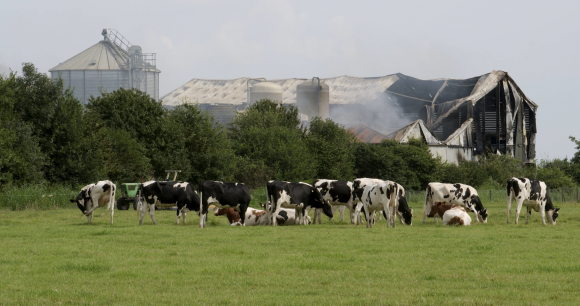
Washington, DC—More than 150,000 farm animals perished in potentially preventable barn fires in the United States in 2018, an Animal Welfare Institute (AWI) analysis of media reports to date has found.
Of the 148 barn fires tracked in 2018—nearly double the number documented one year prior—Wisconsin reported the most fires (19), followed by Ohio (18) and New York (18). The number of fires and animal deaths likely exceeds that total, because laws and regulations vary by state, and municipalities are not generally required to report barn fires and livestock losses that occur within their boundaries.
The 2018 barn fire tally follows an AWI report released in October, which highlighted the more than 2.7 million farm animals who died in 326 separate barn fires from 2013 to 2017. Barn fires happened most often in the Upper Midwest and Northeast, according to that report, and were more common in winter months due to malfunctioning or improperly placed heating devices.
“Given the massive scale of industrial farming and the potential for hundreds of thousands of animals to die in one fire, it is imperative that fire prevention and suppression become a priority in the animal agriculture industry,” said Alicia Prygoski, AWI’s farm animal policy associate.
In 2018, the five barn fires with the highest number of farm animal deaths, as reported by the media, were:
- December 4: 50,000 chickens at Mussman’s Back Acres in Grant Park, IL.
- October 22: 26,000 ducks at an unknown farm in Waynesboro, PA.
- June 18: 25,000 chickens at Draper Valley Farms in Tenino, WA.
- February 26: 14,000 chicks at Draper Valley Farms in Mt. Vernon, WA.
- December 26: 10,000 turkeys at an unknown farm in Washington, IN.
Currently, there are no laws or regulations in the United States designed to protect farm animals from barn fires. AWI offers several recommendations to minimize the risk of these devastating blazes. Among them: Installing fire and smoke alarms; implementing fire training for farm employees; and requesting annual barn inspections from local fire departments. Additional recommendations are included in AWI’s recent barn fire report.
“We hope to reduce suffering,” Prygoski said, “by raising awareness about the prevalence and severity of barn fires, and by offering fire safety recommendations for all sizes of barns and farms.”
Margie Fishman, (202) 446-2128, [email protected]